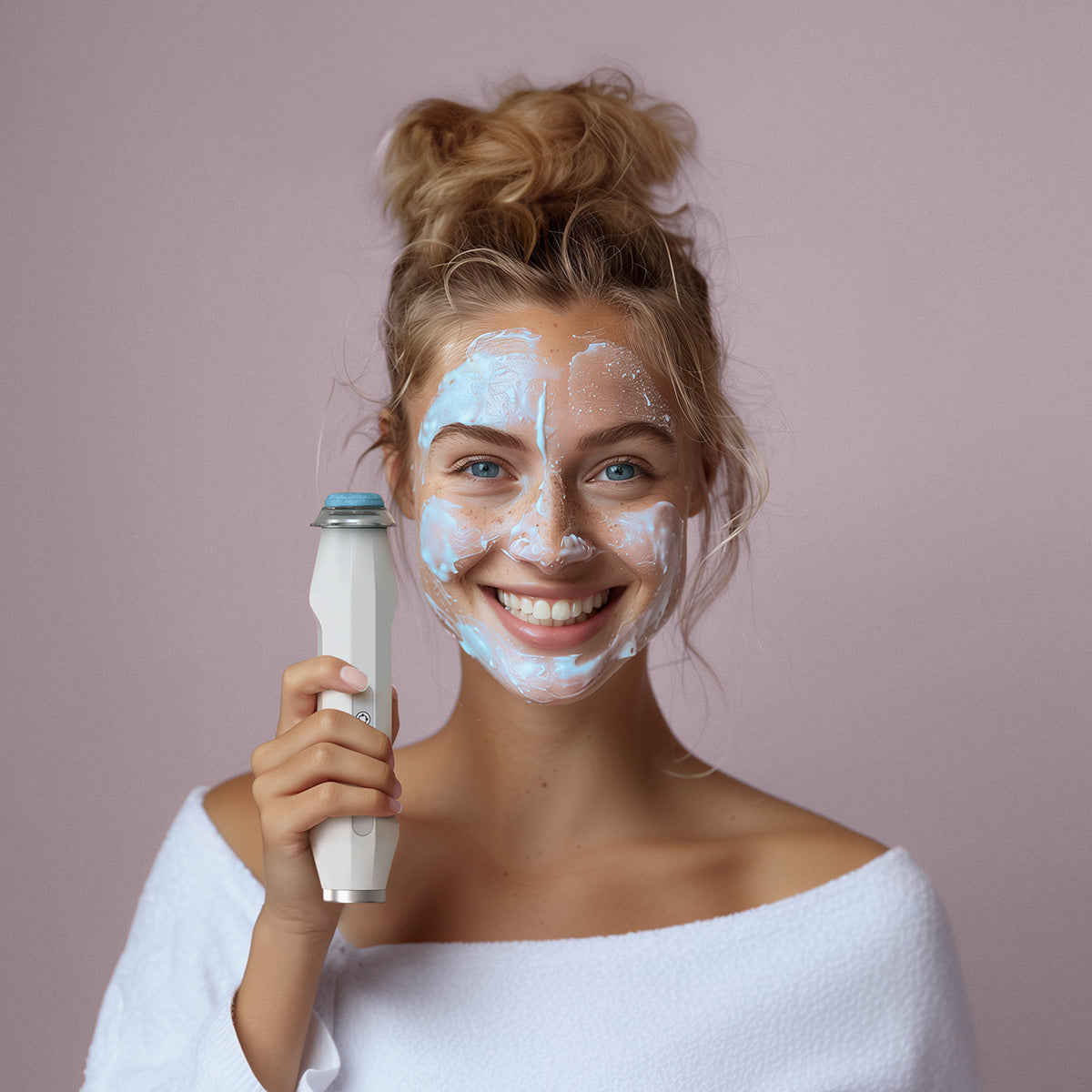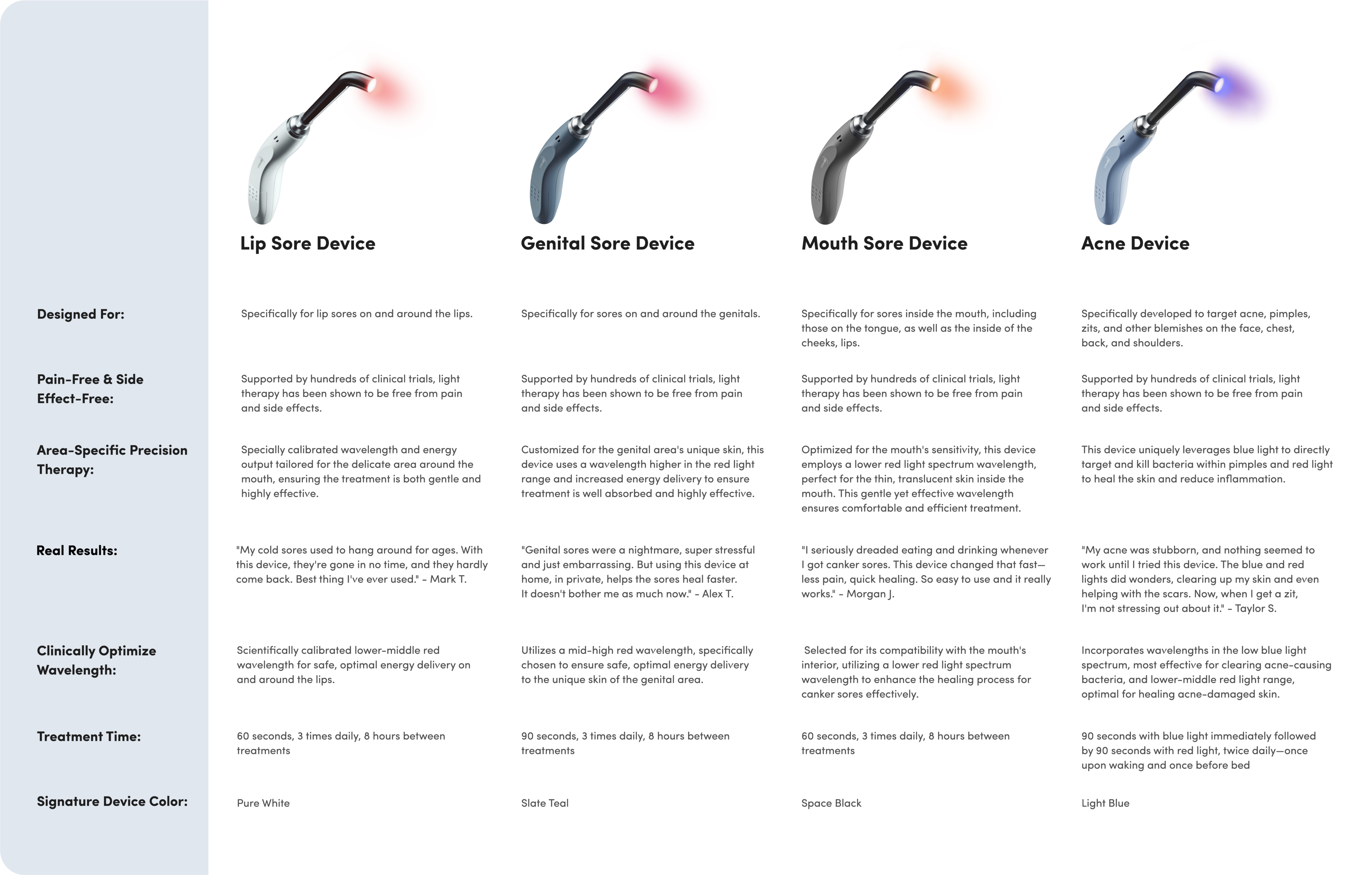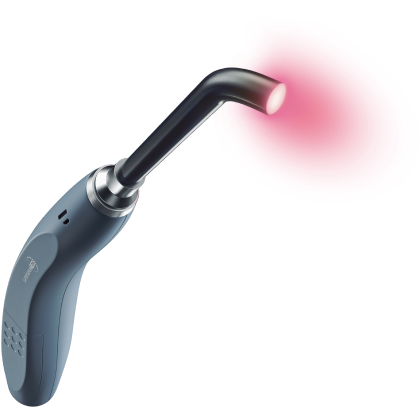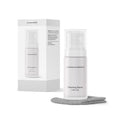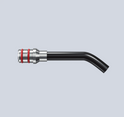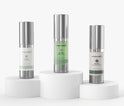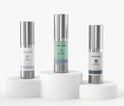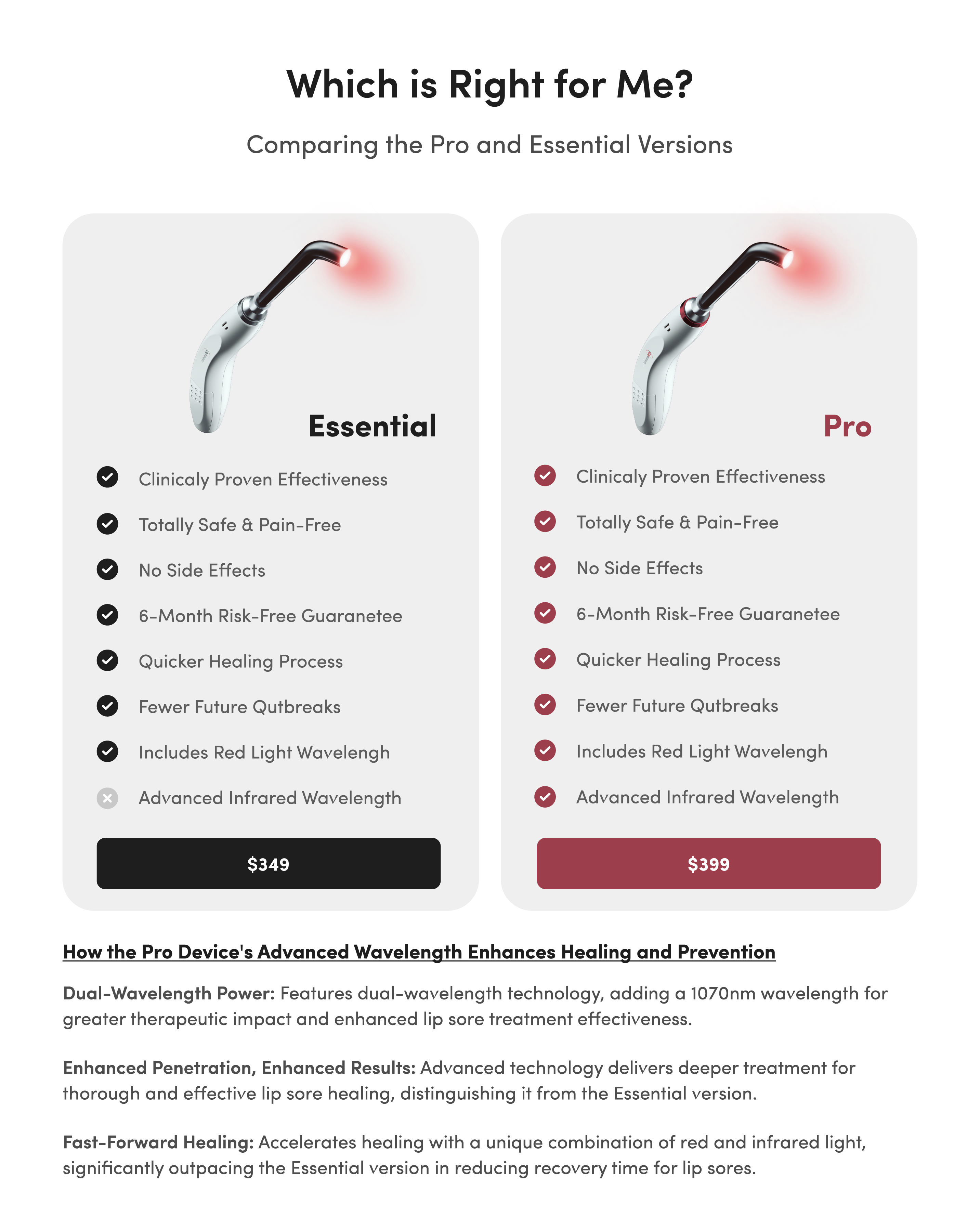New Canker Sore Laser Treatment Now Available

If you’ve ever suffered from a canker sore, you know one shallow mouth ulcer can disrupt your entire life.
It’s hard to believe that a little mouth sore can cause so much pain, but most cankers aren’t messing around — and if you suffer from frequent canker sores, you probably want to know how to get rid of them as fast as possible.
In most cases, conventional treatments for these painful lesions, sometimes called aphthous stomatitis, just don’t do enough. By the time you notice the initial stage of the canker sore, it’s too late to do anything beyond symptom management.
But what if there’s another way?
The Luminance RED is a new canker sore laser treatment device that can heal cankers in just two minutes a day. Plus, clinical research demonstrates canker sore laser treatment is safe to use on people of all ages.
Keep reading to learn everything you need to know about canker sores and treatment options, including canker sore laser treatment.
What Are Canker Sores?
Canker sores, or aphthous ulcers, are shallow white lesions with inflamed pink or red borders that can form on any of the soft surfaces inside your mouth. The sores typically only reach five millimeters in diameter, which is about the size of a coriander seed.
Raw canker sores can make it challenging to eat, sleep, and speak, and even with traditional therapies, they often take at least a week or two to heal.
What Is Light Therapy?
Light therapy is a powerful, natural treatment option for a wide variety of skin conditions.
Light therapy works by exposing the skin to specific wavelengths of light for various periods of time. The light penetrates the layers of your skin, leading to positive changes on the cellular level.
Here are just a few of the skin-healing benefits of light therapy:
- Reducing inflammation
- Boosting collagen and elastin production
- Treating signs of aging
- Treating dark spots and sun damage
- Killing acne-causing bacteria
- Reducing the severity of acne breakouts
- Increasing blood flow
- Expediting cell turnover and healing
Each wavelength of light has its own skin-healing superpower. Finding the right combination depends on the condition you’re treating.
What’s the Difference Between Canker Sores and Cold Sores?
The terms “cold sore” and “canker sore” are often used interchangeably, but they’re actually two distinct problems. To recognize which is which, you need to know the differences between them.
The herpes simplex virus type 1, or HSV-1, causes cold sores, and this viral infection is very contagious. Cold sores appear as clusters of tiny, pus-filled bumps on the lips and around the outside of the mouth. These painful blisters eventually burst and scab over, and they last up to 10 days.
Cold sores usually occur from infection with HSV-1 rather than HSV-2, which more often causes genital herpes. However, both strains of herpes virus can affect any location on the body.
Minor cold sore outbreaks can be mistaken for irritated skin or a pimple. Many people with HSV-1 never show symptoms after the first outbreak.
Unlike cold sores, canker sores aren’t contagious, and they form inside the mouth rather than outside. Canker sores are non-viral ulcers that resemble white craters with a soft pink or red border.
These shallow sores usually appear a few times per year and last around one week. For some people, however, cankers cause debilitating pain and last two weeks at a time or longer.
What Causes Canker Sores?
Canker sores are challenging to treat because they have no universal, definitive cause. However, the most common triggers for canker sores include:
- NSAIDs (Motrin®, Aleve®)
- Vitamin deficiencies (low vitamin B12 or iron)
- Foods high in citric acid, such as oranges, tomatoes, and some cheeses
- Underlying autoimmune conditions (HIV/AIDs, lupus, Behçet’s disease)
- Chronically high stress or a traumatic life event
- Family history of canker sores
While mouth ulcers are a sign that the body is in distress, genetics may also play a role in outbreaks. However, being genetically prone to canker sores doesn’t mean you have to endure lifelong suffering.
Before discussing the treatment options for canker sores, let’s review the types of cankers you may experience and how to identify each one.
What Are the Different Types of Canker Sores?
Learning the different types of mouth ulcers can be helpful since there are different treatment options for different types of canker sores.
Simple or Minor Canker Sores
Most people will experience a simple or minor canker sore at some point in their lives.
A minor canker sore is a small, shallow lesion, typically measuring one to four millimeters. These mouth ulcers heal on their own within a week or two of appearing. Tough uncomfortable and inconvenient, minor cankers don’t cause debilitating pain or leave scarring.
Major Canker Sores
Think of major canker sores as a more severe version of minor canker sores. They’re generally larger — instead of measuring them in milliliters, clinicians measure major canker sores in centimeters. They can grow as large as one to three centimeters, which is about the size of a grape.
Major cankers also sink more deeply into the tissue than minor cankers, and they lack a red or pink border. They’re also extremely painful and may take six weeks or more to fully heal. Because of their size and severity, they can leave a scar behind.
Complex Canker Sores
Like major cankers, complex canker sores grow larger than simple canker sores. They can measure up to five millimeters, or about the size of a pea.
These painful lesions take longer to heal, as well — symptoms can last from one month to six weeks. They’re known for being exceptionally painful, and they may leave a scar behind.
Complex canker sores often indicate a more serious underlying cause, such as a vitamin deficiency, a weakened immune system, or a chronic disease like Crohn’s disease.

Herpetiform Canker Sores
The least common type of aphthous ulcers are herpetiform canker sores, which get their name from their resemblance to herpes-induced cold sores. During an outbreak, tiny white sores form in clusters of as few as 10 to over 100. When the painful lesions cluster close enough together, they can appear to merge into one large mouth sore.
As with other cankers, however, herpetiform canker sores are not caused by the herpes virus.
The definitive cause of herpetiform canker sores is unknown, but many medical professionals believe you’re more susceptible to these small, shallow sores when your immune system reacts to an outside force. A few possible triggers include:
- Severe stress
- Acidic or spicy foods
- Oral products containing sodium lauryl sulfate
- Vitamin deficiency
- Hormonal fluctuations
Herpetiform cankers may also be a sign your immune system is responding to a specific condition, like inflammatory bowel disease, another inflammatory condition, or a virus.
Chronic Canker Sores
Any of the above types of canker sores can recur often enough to be considered a chronic condition.
Chronic canker sores, also called recurrent aphthous stomatitis, are a particularly challenging health issue. Just when you believe you have them under control, another nasty white lesion pops up.
Since there’s no universal cause of cankers, it’s important to rule out common triggers. These include:
- Food allergies
- Acidic, abrasive, or spicy foods
- Irritating ingredients in oral care products
- Vitamin/mineral deficiencies
- Mouth injuries from braces, rough brushing, or over-flossing
If you eliminate these common triggers but still aren’t sure what’s causing your chronic canker sores, it may be time to schedule an appointment with your doctor or dentist. They can investigate further and test for more serious underlying causes, such as an autoimmune condition.
Treating Canker Sore Symptoms
Canker sores trigger painful and uncomfortable symptoms you definitely don’t want to endure for a long period of time. Common symptoms of mouth sores include crater-like ulcers, mouth pain, difficulty eating, and a burning or tingling sensation around the site of the sore.
Fortunately, you can experiment to identify a few simple treatments that directly tackle your worst symptoms.
While any type of canker sore can benefit from canker sore laser treatment, there are a wide variety of other treatment options you can consider, as well. Let’s explore the most popular treatments for mouth sores so you can make an informed decision about whether canker sore laser treatment is right for you.
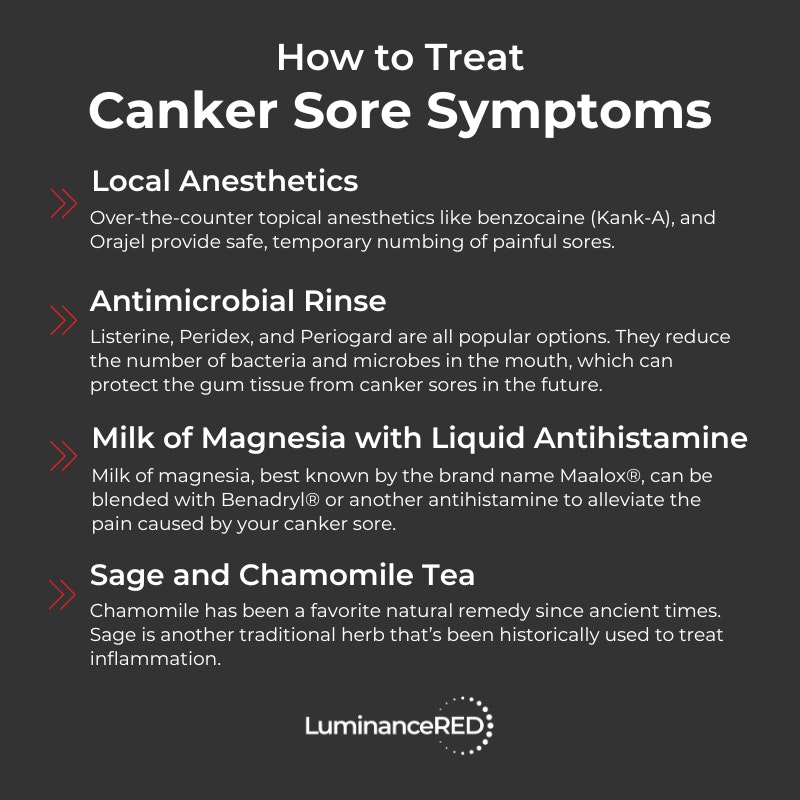
Local Anesthetics
Over-the-counter topical anesthetics like benzocaine (Kank-A®), and Orajel™ provide temporary numbing of painful mouth sores. You can apply local anesthetics a few times per day to relieve discomfort until your canker sore heals completely.
Remember that benzocaine is not appropriate for children under two years old because of the risk for a serious and life-threatening side effect. For older children and adults, always follow the instructions on the package.
Antimicrobial Rinse
Your dentist or doctor may also prescribe an antimicrobial rinse if you’re susceptible to canker sores. Listerine, Peridex, and Periogard are all popular options. They reduce the number of bacteria and microbes in the mouth, which can reduce inflammation and prevent gum tissue from developing painful lesions in the future.
The deep cleaning effect of antimicrobial rinses can also prevent canker sores from becoming aggravated by excess bacteria.
Milk of Magnesia With Liquid Antihistamine
Milk of magnesia, best known by the brand name Maalox®, can alleviate the pain caused by canker sores when blended with Benadryl® or another antihistamine. Milk of magnesia is an antacid that coats the canker sore to prevent irritation, while antihistamines treat inflammation and create a sedative effect.
If your canker sore is uncomfortable and prevents you from sleeping, this combination may be a helpful solution.
Sage and Chamomile Tea
Chamomile tea heals wounds and eases pain through its anti-inflammatory and antiseptic compounds. You can use a chamomile tea bag as a warm compress to soothe angry canker sores, or you can rinse freshly brewed chamomile tea in your mouth for the same effect.
Sage is another herb that’s historically been used to treat inflammation associated with painful sores. Add boiling water to fresh sage leaves and steep for five minutes; then, swish the rinse around your mouth for two minutes.
The antibacterial, anti-inflammatory, antiseptic, and astringent properties of sage may relieve canker sore pain and bring relief to your mouth.
Lysine
Lysine is an essential amino acid that the body cannot produce on its own. Although it’s found in everyday foods, taking a lysine supplement with up to 2,000 milligrams per day may combat and prevent painful cankers.
Canker Sore Light Treatment
You may feel frustrated by the unpredictability of canker sore outbreaks and the ineffectiveness of current treatment regimens. Thankfully, you have another option.
As mentioned above, light treatment can make a world of difference. By holding a soothing wavelength of medically optimized light to the lesion (or where you suspect it may form), your skin receives a burst of powerful energy that can immediately reduce pain and expedite healing time by 49%.
The Luminance RED is an FDA-registered device that harnesses light therapy as an alternative to traditional therapies. Designed specifically for managing canker sores, the Luminance RED nourishes the skin with a 630-nanometer wavelength of light, which cells can metabolize to accelerate the body’s healing process and strengthen its defenses against future attacks.
Clinical Studies Supporting Canker Sore Light Treatment
Low-level laser therapy, or LLLT, is a type of laser therapy used to treat a wide variety of health concerns, including recurrent aphthous stomatitis. At-home light treatment creates the same conditions as low-level laser therapy and offers an advanced, innovative, and convenient method to address painful canker sores.
A common LLLT therapy technique uses diode lasers to treat the soft tissues of the body. This painless therapy has gained popularity over the last several years, and researchers have found no adverse side effects, including with canker sore laser treatment.
And it isn’t just guesswork. Clinical studies show the efficacy of canker sore laser treatment in treat irritating mouth lesions. The following is the proof you need that light treatment is one of the best ways to tackle your worst canker sores:
Clinical Evaluation of Low-Level Laser Treatment for Recurrent Aphthous Stomatitis
One recent placebo-controlled study concluded that when a certain wavelength of red light is applied to canker sores, it reduces the average healing time from 8.9 days (control group) to 3.1 days (treatment group).
This means soft tissue laser therapy is one of the most effective treatment options available for soft tissue injuries like cankers.
On a day-by-day basis, the group that received light treatment saw a dramatic reduction in the size of the sore when compared to the group that received no treatment at all.
Assessment of Immediate Pain Relief With Laser Treatment in Recurrent Aphthous Stomatitis
Another study examined how applying low-level laser treatment to canker sores impacted the levels of pain in patients. The group that received treatment immediately experienced a 92% reduction in pain versus a 1% reduction in the placebo group.
The same study also found a nearly 50% reduction in healing time between the two groups, with an average time to complete healing in the treatment group of 4.08 days and 7.84 days in the group not receiving treatment.
Clinical Assessment of the Therapeutic Effect of Low-Level Laser Therapy on Chronic Recurrent Aphthous Stomatitis
An important step in the healing process is epithelialization, which refers to the initial healing barrier of cells forming over the sore.
In one study, researchers found that applying a low-level laser treatment to canker sores reduced the time necessary to reach this important step in the healing process.
Only 24 hours after the treatment, 77% of patients in the study who received LLLT reached the epithelialization phase of healing, compared to none of the patients in the untreated group.
Efficacy of Low-Level Laser Therapy in Treatment of Recurrent Aphthous Ulcers — A Split Mouth Follow-Up Study
Still not sure whether canker sore laser treatment is right for you? Another study monitored the effect of canker sore laser treatment on lesions treated with LLLT over four sessions completed in a single sitting. Researchers evaluated each patient for pain, lesion size, and complete healing immediately after treatment and also after one, two, and three days following LLLT treatment.
Results show that the patients treated with low-level laser therapy had a healing time of about 3 days, compared to the control group’s average healing time of nine days. Out of the 30 patients in the LLLT treatment group, 28 experienced complete pain relief immediately after treatment.
These clinical studies and others — such as this study on the Luminance RED — clearly demonstrate the effectiveness of low-level laser treatment for canker sores, including its ability to quickly relieve pain and significantly reduce healing time.

Canker Sore Laser Treatment: Conclusion
While canker sore laser treatment might not bring instant healing, especially when dealing with complex canker sores, major canker sores, and chronic canker sores, this type of therapy significantly reduces pain and inflammation and expedites healing time.
In case you’re still on the fence, remember that you can purchase FDA-registered light therapy devices, such as the Luminance RED, for an affordable price. If you’re not satisfied with the results, the Luminance RED comes with a six-month, 100% money-back guarantee.



